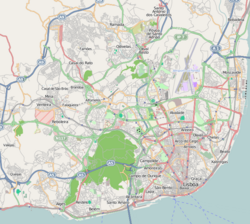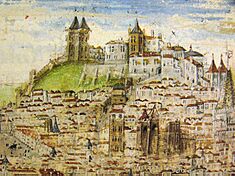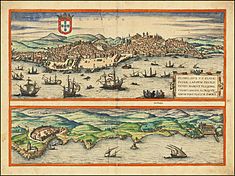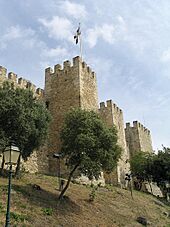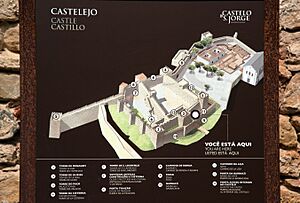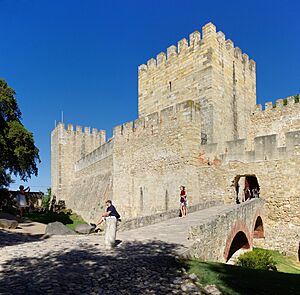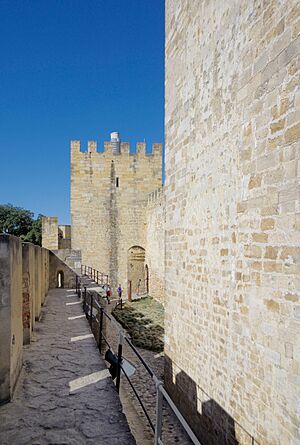São Jorge Castle facts for kids
Quick facts for kids São Jorge CastleSaint George's Castle |
|
|---|---|
| Castelo de São Jorge | |
| Lisbon in Portugal | |
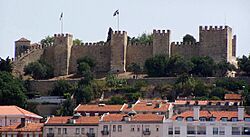
The visible profile of Saint George's Castle overlooking the historical center of Lisbon.
|
|
| Coordinates | 38°42′50″N 9°08′01″W / 38.71389°N 9.13361°W |
| Type | Castle |
| Site information | |
| Owner | Government of Portugal |
| Operator | Câmara Municipal de Lisboa |
| Open to the public |
Public |
| Site history | |
| Built by | Kings of Portugal, most notably Ferdinand I, Denis and Sebastian João Fernandes and Vasco Brás |
| Materials | Stone, Granite, Reinforced concrete |
São Jorge Castle (Portuguese: Castelo de São Jorge), also known as Saint George's Castle, is a super old and important castle in Lisbon, the capital city of Portugal. It's located in an area called Santa Maria Maior. People have lived on this castle hill for a very, very long time – since at least the 8th century BC! The very first defensive walls were built here around the 2nd century BC.
This hill has been super important throughout the history of Lisbon. Different groups like the Phoenicians, Carthaginians, Romans, and Moors all built their own forts here. Finally, the Portuguese took it over in the year 1147 during the Siege of Lisbon. Since the 12th century, the castle has been many things: a royal palace for kings, a place for soldiers (military barracks), home to the national archives (important historical documents), and now it's a national monument and a cool museum you can visit!
Contents
The Story of São Jorge Castle
The first proper fort on this hilltop was probably built around 48 BC, when Lisbon became a Roman city. But even before that, archaeologists have found signs that people lived in this area as far back as 800 BC!
Ancient Roots: Before Portugal
Before the Portuguese, many different groups used this hill as a defensive spot. First, there were Celtic tribes, then the Phoenicians, followed by the Greeks, and later the Carthaginians. Over time, the Romans, the Suebi, the Visigoths, and finally the Moors took control. During the 10th century, the Berber forces (who were Moors) built strong walls around the castle, known as the Cerca Moura (which means "Moorish Encirclement").
A Royal Home: Portugal Takes Over
In 1147, during a time called the Reconquista (when Christian kingdoms in the Iberian Peninsula fought to reclaim land from Moorish rule), the castle and the city of Lisbon were captured by Afonso Henriques, the first King of Portugal, and knights from northern Europe. This happened during the Siege of Lisbon, which was part of the Second Crusade. This victory was a big success for the Christians.
There's a famous legend about this battle: a brave knight named Martim Moniz saw that one of the castle gates was slightly open. To stop the Moors from closing it, he threw his own body into the gap, holding it open long enough for the Christian soldiers to rush in. He died, but his sacrifice helped win the castle! After taking the castle, Christian forces could defend Lisbon well.
When Lisbon became the capital of the Kingdom of Portugal in 1255, the castle became the alcáçova, which was a fortified home for King Afonso III. Around 1300, King Denis I made big changes, turning the old Moorish fort into the Royal Palace of the Alcáçova.
Between 1373 and 1375, King Ferdinand I ordered a new wall to be built, called the Cerca Nova or Cerca Fernandina. This wall was huge, about 5.4 kilometers (3.3 miles) long, with 77 towers and many gates. It was built to protect parts of the city that weren't covered by the older Moorish walls.
The castle and city successfully defended themselves against attacks from Castile many times in the 14th century. It was around this time (the late 14th century) that King John I dedicated the castle to Saint George. He had married an English princess, Philippa of Lancaster, and Saint George, a warrior-saint often shown fighting a dragon, was very popular in both Portugal and England.
From 1378, many of Portugal's important historical records were kept in a tower called the Torre do Tombo (meaning "Tower of the Archive"). This tower is now known as the Tower of Ulysses. Famous Portuguese historians like Fernão Lopes worked there.
In the early 15th century, a royal zoo was set up near the castle. After conquering Ceuta in 1415, King John I brought back two Barbary lions, which lived in a special room in the palace. This area became known as Casa dos Leões (the "Lions' House"), and today there's a famous restaurant there with the same name!
The castle was also a place for important events. In 1498, King Manuel I welcomed the famous explorer Vasco da Gama here after he discovered the sea route to India. In 1502, a play was even performed at the castle to celebrate the birth of Manuel I's son, who would become King João III.
The Castle's Changing Roles
Around the early 16th century, the castle started to lose its importance as a royal home because a new palace, the Ribeira Palace, was built closer to the Tagus river. An earthquake in 1531 also damaged the old castle, making it even less used.
In 1569, King Sebastian ordered the royal apartments in the castle to be rebuilt, planning to live there. However, many of these plans were never finished because the young king disappeared during the Battle of Alcácer Quibir. After this, Portugal was ruled by Spain for sixty years, and the castle was turned into military barracks and a prison.
After Portugal regained its independence in the Portuguese Restoration War, the Portuguese government took over the castle. They continued to rebuild and strengthen it. In 1673, a hospital for soldiers was built on the grounds.
The terrible 1755 Lisbon earthquake severely damaged the castle again, leaving many parts in ruins. Because it was important to have soldiers in the capital, the castle continued to be used as a military base. From 1780 to 1807, a charity called Casa Pia, which educated poor children, was also located in the castle, while soldiers were still stationed there. After the earthquake, the first geodetic observatory in Portugal (for studying the Earth's shape) was built in 1788 at the top of one of the castle towers, now called the Observatory Tower.
Modern Times: A National Treasure
By the 1930s, the castle was almost hidden by other buildings and additions. It was hard to even see it from the Lisbon skyline! As part of celebrations for Portugal's history and independence, the government of António de Oliveira Salazar started a huge project to restore the castle. Most of the newer, mismatched buildings were torn down, and parts of the old castle were rebuilt. In 1947, a statue of Afonso Henriques, the first king, was placed on the grounds.
Since 1942, the city government of Lisbon has been in charge of the castle's operations. In 1998, some of the castle's spaces were turned into a museum called Olissipónia, which tells the history of Lisbon using multimedia.
Today, São Jorge Castle is a protected historical site, and it's a fantastic place to visit to learn about Lisbon's past and enjoy amazing views!
Exploring São Jorge Castle Today
The castle is right in the middle of Lisbon, sitting on top of a hill. Its walls spread out around the main castle into the areas below.
The castle is generally square-shaped and was originally surrounded by a wall, forming a citadel (a strong fortress protecting a city). The whole castle area includes the main castle itself (called the castelejo), some other buildings (including the ruins of the royal palace), beautiful gardens, and a large open square with terraces that offer incredible views of Lisbon.
The main entrance to the castle area is a gate from the 19th century. Above it, you can see the coat-of-arms of Portugal, the name of Queen Maria II, and the date 1846. This gate leads you into the main square (Praça d'Armas), which has old cannons and a bronze statue of Afonso Henriques, the Portuguese king who captured the castle from the Moors.
The remains of the royal palace are near the main square, but only some walls and a few rebuilt rooms, like the Casa Ogival, are left. This area now hosts the Olissipónia, a cool multimedia show about Lisbon's history.
The medieval castle itself is in the northwest corner of the whole complex, at the very highest point. Imagine if attackers managed to get into the outer areas – the castle was the last place to hide and defend! It's rectangular with ten towers. A wall with a tower and a connecting door divides the castle courtyard into two halves. You can climb up a series of stairways to walk along the top of the walls and towers, where you get amazing views of Lisbon. The Tower of Ulysses (where the old Torre do Tombo archive used to be) has a camera obscura installed since 1998. This is a special device that lets you see a 360-degree view of the city and the Tagus River projected inside a dark room – it's really neat!
Besides its main walls, the castle is protected on its south and east sides by a barbican. This is a low wall that stopped siege engines (like battering rams) from getting too close to the main castle walls. The north and west sides of the castle were naturally protected by the very steep hillside. The castle also has a moat around part of it, which is now dry. The main entrance has a stone bridge crossing this moat. On the west side, a long wall goes downhill, ending at a tower called the Torre de São Lourenço. This tower guarded a gate in the Cerca Fernandina (the new wall built by King Ferdinand I).
See also
- Castles in Portugal
- History of Lisbon


